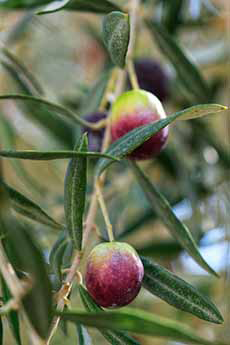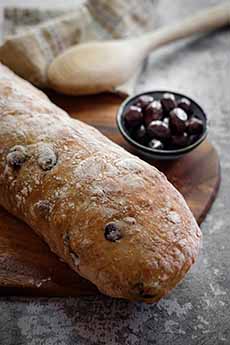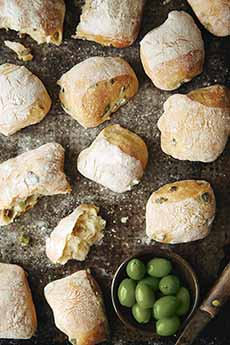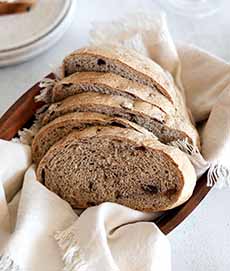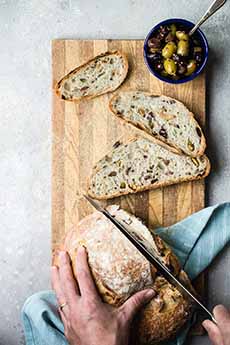Savory Olive Oil Loaf Cake Recipe For National Olive Day
|
June 1st is National Olive Day, celebrating what is likely the second-earliest-cultivated fruit (figs were first). The history of olives is below. Our featured recipe, created by Colavita Olive Oil, is called a “savory loaf cake.” It’s made with a combination of AP flour and cornmeal, plus olives and olive oil. As a bonus: cheese! The baked product is called a cake because, while savory, its crumb (the interior—i.e., everything under the crust) resembles a sweet loaf cake, also called a bread (zucchini bread, pumpkin bread, e.g.). If it were called olive bread—even an olive-semolina bread—you’d be expecting something very different (see photos #3, #4, #5, and #6). Call it what you like: It is so delicious, that one loaf isn’t enough. Next time, we’ll make four loaves: One for Day 1, one for Day 2, and two for the freezer. We ate it plain, with breakfast eggs, with soup and salad at lunch, and with grilled chicken and seafood at dinner (it goes with everything). We ate it buttered or slathered with cream cheese or other fresh cheese as a snack. We even added fig spread, and it was a nice counterpoint to the slight saltiness of the olives. And if we hadn’t finished the loaf, we’d have tried it with Greek/Mediterranean mezze. > The history of olives is below. One question to decide up-front is what type of olive to use. Our preference is for full-on Mediterranean black olive flavors, such as Gaeta, Kalamata, and Niçoise varieties. If you prefer a green olive, use Castelvetrano or Picholine. Prep time is 10 minutes, and cook time is 45 minutes. ________________ *Substitute Emmental, Gouda, Gruyère, or Provolone Preparation 1. PREHEAT the oven to 350°F. Oil a 5″x9″ loaf pan. 2. WHISK together the flour, baking powder, salt, and pepper in a large bowl. 3. LIGHTLY WHISK the eggs in a medium bowl, then whisk in the milk and olive oil. 4. FOLD the wet ingredients into the dry with a rubber spatula, just until barely mixed. Fold in prosciutto, olives, and cheese. Scrape the batter into the pan and smooth the top. 5. BAKE the loaf until the top is golden and a toothpick inserted into the center comes out with just a few crumbs attached, 45 minutes. 6. COOL the loaf in the pan for 5 minutes. Run a knife around the edges to release. Allow loaf to cool on a rack for about 30 minutes before slicing. The olive was first domesticated in the Eastern Mediterranean between 8,000 and 6,000 years ago, according to new research, which indicates that they were probably first cultivated from wild olive trees in Asia Minor, at the frontier between what is now Turkey and Syria [source]. From there it spread to Iran, Palestine, and the rest of the Mediterranean. As mentioned earlier, among the world’s cultivated trees, it is second only to the fig. It was grown before the written language was invented. That’s perspective! The Spaniards took olive cuttings to the New World in the mid-sixteenth century, first to Peru. From there, Franciscan Monks moved northward establishing missions and taking olives to Central America. In 1769, they planted the first olive cuttings in California at the San Diego Mission (hence, the name Mission olive). Olives thrived in California’s climate. Over the past several hundred years the olive has spread to North and South America, Japan, Australia, and New Zealand [source]. In the U.S., Franciscan monks establishing missions in California also planted olive groves. Southern California saw the first olive trees. But all of the California olives were pressed into oil, which was used for food, fuel, grooming, medicine, and religious rites. Thousands of acres of olive trees were planted in response to the high demand for olive oil in the 1800s. When the market became saturated (ironically, with monounsaturated oil), prices dropped, and farmers were tasked with finding an alternative use for their olive trees. A grower named Freda Ehmann came up with a resourceful solution to the industry’s problem. After consulting with a U.C. Berkeley professor about processing methods, she began experimenting with pickling methods and discovered a formula that resulted in table olives (i.e., those eaten directly or used in creating recipes), that could be sold loose from containers or prepackaged. product. Thanks to her initiative, the condiment* olive industry was born [source]. The olive, Olea europaea, is a member of Oleaceae, known as the olive family, with 27 extant genera. Botany geeks can go up one level, to the order, Lamiales, one of the largest orders of flowering plants, which includes the ash tree, basil, garden sage, jasmine, lavender, lilac, mint, olive, rosemary, sesame, snapdragon, and teak. |
|
|
|
________________ *What is a condiment? A condiment is an auxiliary food product that adds flavor to another food. While we normally think of capers, chutney, gravy, hot sauce, mayonnaise, mustard, oil, tartar sauce, soy sauce, vinegar, and Worcestershire sauce as condiments, the category includes “standalone” products such as olives and pickles, as well. The definition in Merriam-Webster is, “something used to enhance the flavor of food, especially a pungent seasoning.” They pinpoint the first use of the word in the 15th century. The term condiment comes from the Latin condimentum, meaning “spice, seasoning, sauce,” and from the Latin condire, meaning “preserve, pickle, season.” The term originally described pickled or preserved foods, but its meaning has changed over time. CHECK OUT WHAT’S HAPPENING ON OUR HOME PAGE, THENIBBLE.COM.
|
||

